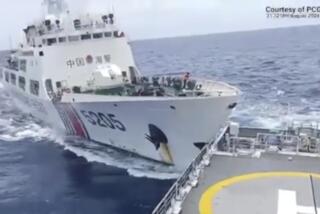China wages stealth war in Asian waters
- Share via
BEIJING — When a two-engine Chinese turboprop darted over disputed islands in the East China Sea, the first foreign intrusion into Japanese airspace in more than 50 years, the People’s Liberation Army was able to truthfully profess its innocence.
The tiny turboprop belonged to China Marine Surveillance, a once-obscure cog in the vast bureaucracy that has become a kind of paramilitary force in Asian waters.
A host of Chinese agencies with innocuous titles -- the Maritime Safety Administration, the Fisheries Law Enforcement Command, the State Oceanic Administration -- have become stealth warriors in Beijing’s campaign to press its territorial claims in Asian waters.
The intrusion on Dec. 13 sent Japanese fighter jets scrambling, bringing the two Asian powers that battled each other during World War II close to outright conflict.
“We had nothing to do with it,” a Chinese admiral told a U.S. military analyst at a conference last month in Singapore. “We were not consulted in advance.”
American concerns about Beijing’s growing maritime reach invariably focus on China’s first aircraft carrier, the Liaoning, a rebuilt Soviet vessel that went into operation last year. Or on the projected 10.7% increase in the defense budget for 2013, the latest in a decade of double-digit hikes. Little is said about the nonmilitary agencies that are operating under the radar.
“It is a brilliant strategy by China to establish their control over an area without firing a single shot,” said Stephanie Kleine-Ahlbrandt, head of the Beijing office of the International Crisis Group, a think tank that works on conflict resolution.
China claims sovereignty over a U-shaped dip of the South China Sea touching on waters also claimed by the Philippines, Vietnam, Malaysia, Brunei and Indonesia. Beijing also faces territorial disputes with Japan and South Korea in the East China Sea. New techniques in underwater oil and gas extraction have enhanced the lure of otherwise barren rocks and submerged reefs.
Chinese President Xi Jinping has made what many in China call “core interests” one of the themes of his new administration.
The game is to deploy civilian agencies on the front lines, giving the military plausible deniability and allowing China to avoid serious repercussions.
The People’s Liberation Army’s navy always hovers in the background. In one instance, Japan claims, the navy pointed its radar at a Japanese ship, and Vietnam on Monday accused China of opening fire on a fishing boat. But this for the most part has been a cold -- and wet -- war waged not with bombs or bullets but with water cannons, buoys, fishing nets, surveying equipment and seismic cables.
Not deadly, but perhaps more effective. In April, Chinese marine surveillance and fisheries command ships sailed into what is known as Scarborough Shoal to prevent the Philippine navy from arresting Chinese fishermen accused of poaching protected species. The Chinese vessels never left and have in effect blocked Philippine fishermen from a lagoon they have fished for generations. The shoal lies about 150 miles off the Philippine coast and more than 500 miles southeast of Hainan, China’s southernmost island.
“If the Chinese had come into the Scarborough Shoal with their navy, the whole world would have gone crazy. It would scare the hell out of the neighbors and justify the U.S. going in,” said Bonnie Glaser, a military analyst with the Washington-based Center for Strategic and International Studies. The U.S. is fumbling to meet the challenge, she said: “It is not like we can send our own Coast Guard to the South China Sea.”
Among the Chinese agencies, the most powerful player is the State Oceanic Administration, which oversees China Marine Surveillance. During the National People’s Congress this month, the administration’s control was expanded to include the Fisheries Law Enforcement Command and coast guard. Since May 2011, the administration has been headed by Liu Xigui, a former military official who worked in the coastal city of Fuzhou at the same time Xi was based there.
In a rare interview with the official New China News Agency, Liu said his administration’s role is “to secure the nation’s maritime rights and interests.”
U.S. Navy Capt. James Fanell, a senior intelligence officer of the Pacific Fleet, at a Jan. 31 conference in San Diego called the China Marine Surveillance a proxy for the military and a “full-time maritime sovereignty harassment organization.”
“Chinese marine surveillance cutters have no other mission but to harass other nations into submitting to China’s expansive claims. Mundane maritime government tasks like search-and-rescue, regulating fisheries, ice breaking and criminal law enforcement are handled by other agencies,” Fanell said in an unusually blunt assessment.
According to Fanell, since 2008 the agency has tripled the number of patrols it conducts. Its ships travel up to 900 miles from China, within dozens of miles of other countries’ shores. “If you map out their harassments, you will see they form a curved front that has over time expanded out against the coasts of China’s neighbors.”
Since 2000, the People’s Liberation Army has transferred 11 retired warships to China Marine Surveillance, which has built 13 ships and plans to build 36 more, according to articles in the Chinese state media.
The ships operate like riot police at sea. They aren’t armed, but they have nonlethal gizmos such as high-pressure water cannons that can be used to spray down boats they want to chase away. (A water duel erupted last year between Taiwanese and Japanese boats near the disputed East China Sea islands.)
The Fisheries Law Enforcement Command, which until the recent reorganization was part of the Ministry of Agriculture, received a 5,800-ton former warship last year equipped with a helicopter pad.
“They are turning out these ships like sausages,” said Glaser of the Center for Strategic and International Studies. “The paramilitary [forces] are one reason that the Chinese shipbuilding industry is booming.”
Not to be left out of the action, the National Administration of Surveying, Mapping and Geoinformation announced its intention to survey the Japanese-controlled but uninhabited Senkaku islands, known by the Chinese as Diaoyu.
At the regional level, Hainan island’s government has been taking a leading role pressing China’s claim to the South China Sea. Its provincial congress passed a law in November saying authorities had the right to “board, inspect, seize and expel” boats that stray into what China claims are its waters.
Hainan has also taken charge of developing Woody island, the largest of the Paracels, which were taken from Vietnam in 1974. The island, which has no indigenous inhabitants, lies 200 miles south of Hainan, so developing and populating it will in effect push China’s borders deeper into the South China Sea.
Although less than 1 square mile, the island is supposed to become a tourist hub known as Sansha. Cruise ships are expected later this year.
State-owned oil companies and private fishing ships are also getting into the push for Chinese sovereignty. Two Chinese fishing boats were accused by Vietnam last year of cutting a seismic cable used by its state oil company for exploration in the Gulf of Tonkin. China says the cable was snagged by a fishing net. In the East China Sea, a self-employed fisherman was responsible for one of the most serious incidents when he rammed his trawler into two Japanese coast guard vessels in 2010.
With so many players trying to outdo one another in displays of nationalist fervor, the potential for miscalculation is enormous. Accidents happen in any game of chicken, with the consequences especially dire when aircraft are involved.
“We say that when there are nine dragons guarding the sea, things get messed up,” said Xu Guangyu, a retired military officer.
Xu expects that under the reorganization announced this month, the Chinese agencies will better coordinate their actions with one another and with the military. But he doesn’t expect China to relent in its campaign for greater sovereignty in the waters.
--
Tommy Yang of The Times’ Beijing bureau contributed to this report.
More to Read
Sign up for Essential California
The most important California stories and recommendations in your inbox every morning.
You may occasionally receive promotional content from the Los Angeles Times.










